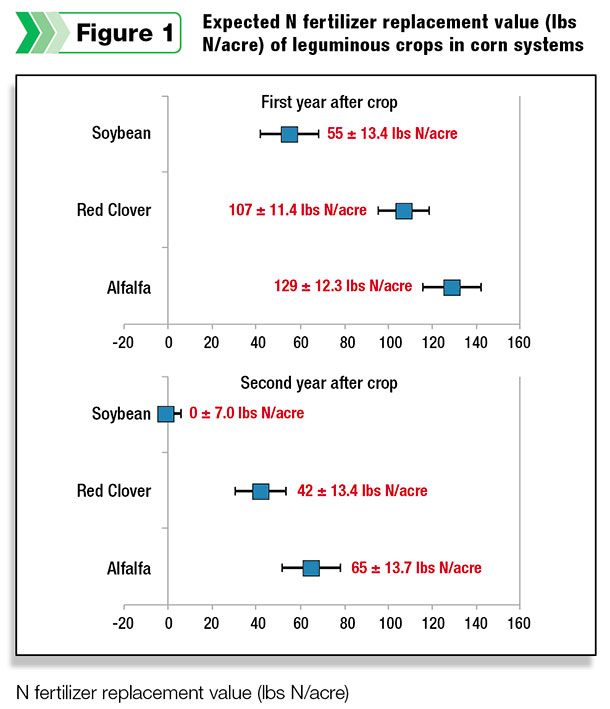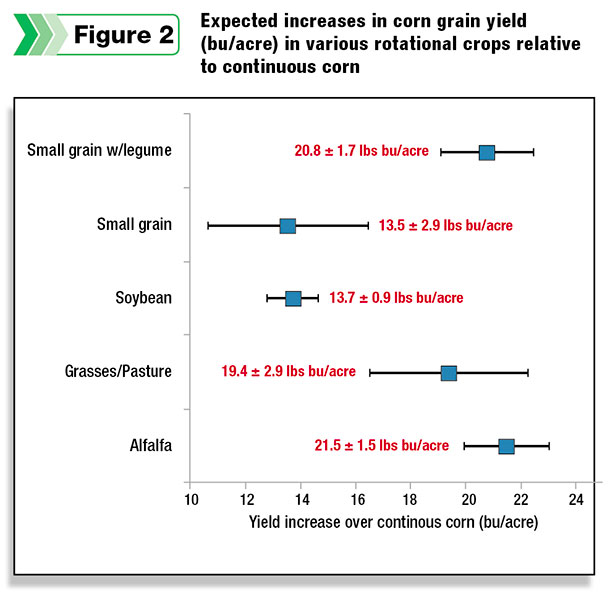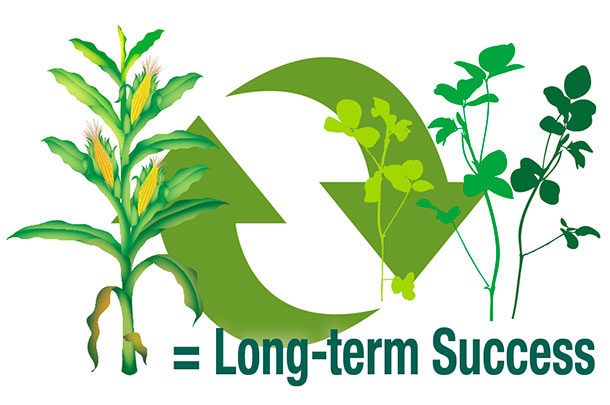U.S. corn acreage has continued to increase in recent years for various reasons including greater market demand, a shift towards larger farms that focus on a fewer number of crops and the development of improved varieties and management practices.
According to the U.S. Census of Agriculture, the acreage devoted to corn and soybeans has risen by 64 and 255 percent over the last 30 years, while the land use for alfalfa and pasture has declined by 15 and 28 percent over the same period.
The loss of forages is particularly evident in the Midwestern states, where acreages of alfalfa and pasture have declined by 67 and 53 percent, respectively.
Despite the shift to “corn-centric” agriculture, the use of perennial forage species such as alfalfa or tall fescue in crop rotations are vital to the long-term success of grain crop operations.
The benefits of forages in crop rotations
There are many benefits that can come from the use of crop rotations, regardless of the species used. Producers can diversify their operation to minimize financial risk, interrupt the life cycle of various diseases and insects, and add flexibility to their weed management program.
Forage species can provide additional benefits over other grain crops. Forage legumes (e.g., alfalfa, clovers, etc.) have the ability to form a symbiosis with Rhizobia that converts atmospheric nitrogen (N) into a form available to the plant, reducing the need for N fertilizers.
Perennial forages also provide year-round vegetation that decreases the loss of soil and nutrients through erosion. The large root system leads to increased deposition of carbon (C) into the soil, improving soil quality traits such as soil aggregate stability, bulk density and water infiltration.
The differences in grains and forages
To better explain, soybeans may have the ability to form a symbiosis with Rhizobia, but they tend to fix less atmospheric N than forage legumes. Research has shown that N fixed by alfalfa would replace nearly 130 pounds of N fertilizer in the first year of corn (Figure 1).

In addition, red clover produced a similar N fertilizer replacement value (NFRV) as alfalfa (107 pounds N per acre), whereas soybeans had an NFRV that was approximately half of these forage species (55 pounds N per acre).
While soybeans are undoubtedly capable of fixing more N, the lower NFRV is likely a result of its grain production. The grain of soybean is exceptionally high in protein, and a large portion of N provided by the Rhizobia symbiosis is allocated to the seed during grain fill.
The N fixed by perennial forage legumes, however, is more evenly distributed between aboveground herbage and reserves within the roots so that more N is retained in the field following harvest.
The amount of N provided by soybeans, although lower than a forage legume, is still a respectable quantity that will have an economical benefit to a producer. However, this benefit has little effect beyond the next growing season due to the annual growth habit of the crop.
Because forages are typically a multi-year phase (two- to three-year) in the rotation cycle, the N fixed by forage legumes is compounded annually and results in a larger reservoir that is slowly mineralized in subsequent years.
This is evident by the fact that alfalfa and red clover are capable of replacing a sizable portion of the N requirement of corn planted two years after these forages, while very little N was present from soybeans (Figure 1).
It should also be noted that N received from forages can be further improved if the crops are used for grazing. In pasture, there is a greater potential for the return of N, as well as other nutrients, because only 20 to 40 percent of the soil nutrients are removed by livestock, compared to nearly 80 to 100 percent with the harvesting of hay. This can have a profound impact on the amount of fertilizer required by the subsequent corn crop.
For example, a cool-season grass hay, such as tall fescue or orchardgrass, with a yield of 3.25 tons dry matter per acre would remove approximately 120 pounds N, 40 pounds P2O5 and 175 pounds K2O on an acre basis. Grazing of the field would restore roughly 80 pounds N per acre, 30 pounds P2O5 and 120 pounds K2O per acre, which correspond to 70 percent, 60 percent and 58 percent of corn’s requirement of these nutrients, respectively.
Allowing stover to remain on the field following the harvest of grain crops may also promote some cycling of soil nutrients, but its nutrient content is considerably lower than forage herbage and may lead to other agronomic issues if present in high quantities.
Increasing C and its effect on soil quality
In addition to improving soil fertility and nutrient cycling, incorporating forages into a crop rotation may improve soil quality by supplying an abundant source of C. To briefly explain, the extensive root system of forage species, combined with the tissue turnover that results from frequent defoliations, provides a pool of C in the soil that effectively acts as “glue.”
This improvement in soil structure leads to a greater infiltration and retention of water, a reduction in soil bulk density and better aeration of the soil.
Rotation with other grain crops may also increase soil C, especially under no-till operations. However, reported benefits received are typically less than those found with rotations including forage species.
A long-term rotational study in Iowa found that a two-year rotation into alfalfa improved soil C by 25 percent compared to continuous corn. Rotation with small grains improved soil C by 10 percent over the same period, while incorporating soybeans into the system had minimal changes in soil C.
Likewise, the stability of soil aggregates increased by 35, 17 and 1 percent for the alfalfa, small grain, and soybean rotations, respectively, indicating a larger potential for forages to improve soil health.
The effect of rotational crops on corn yields
Any of the crop species in the analysis would be expected to increase grain yields when compared to continuous corn (Figure 2). Rotation into other grain species (e.g., soybeans or small grains) resulted in moderate increases in corn yields at 13 bushels per acre, while the use of forages or small grains interseeded with forage legumes (usually red clover) resulted in the largest increases in corn yields at 20 bushels per acre.

Interestingly, there was no difference in corn yields between alfalfa and forage grass pastures (Figure 2). This suggests the nutrient cycling and C deposition that results in pastures may have as large or greater effect than simply providing large quantities of N.
The incorporation of perennial species into the rotation cycle, even for only a few years, may have a greater impact on the sustainability of corn systems. Higher corn grain yields combined with lower fertility requirements and improvements in the soil quality make the use of forages a more profitable long-term investment than other grain crops.
The markets closely associated with forage production have been consistent over the last 15 years when compared to soybeans and wheat. This, in conjunction with the fact that forages are much more forgiving with management miscues, indicate that traditional grain producers should not be afraid to consider adding forages into their systems.
Similarly, forage and livestock producers should begin to reflect on what advantages corn and other row crops may have on their operations, as the “re-integration” of crops into livestock systems may be the key to the future of both commodities. ![]()

-
Ben Goff
- Assistant Professor
- University of Kentucky
- Email Ben Goff











